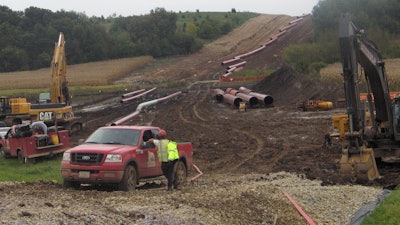
President Joe Biden’s $1.2 trillion Infrastructure Investment and Jobs Act aims to revitalize America’s roads, bridges and railways, in addition to increasing broadband internet access nationwide. If the bill becomes law, contractors can expect to see a major uptick in demand for new construction projects.
However, there’s one major roadblock: the construction industry is short on skilled workers.
A report from the US Chamber of Commerce found that over 88% of contractors are having moderate to high difficulty hiring skilled labor. These hiring problems are contributing to a construction labor shortage of at least 2.2 million workers through 2025. Separate research shows that 41% of construction workers may retire by 2031.
To keep up with demand using a shrinking and less skilled workforce, contractors need ways to retain the workers they have and work more efficiently with less labor. Here are three ways they can do so.
AI Tech Can Make Construction Work More Attractive
A smaller labor pool means it’s likely that each individual worker will have more work. But overwork can drive up injury and turnover rates, further diminishing the available workforce. Contractors can’t afford these setbacks with major projects on the way.
New AI applications can cut down on project planning time and optimize construction scheduling through preplanning and management algorithms. For example, the algorithm designed by ALICE Technologies generates alternative schedule possibilities to advise contractors on the optimal construction path. It helps contractors gauge how large a team they need and how long a workday should be to maximize efficiency without overworking people on site.
With AI technology managing workloads, construction workers will be less likely to be overscheduled and injured from overwork. And with less on-the-job strain, construction as an industry will be more attractive for potential hires.
Telematics Can Prevent Downtime
During a labor shortage, contractors need to be able to constantly monitor their equipment health. Equipment breakdowns require more labor to repair, and slow down existing projects. Too much equipment downtime can create backlogs, further straining capacity to meet increased demand.
Telematics solutions can track equipment health by collecting data from cameras, cloud-connected keypads, bluetooth nodes and vehicle trackers. These tracking elements tell contractors when their equipment needs preventive maintenance so they can get on top of problems before they happen.
As an added benefit, telematics can reduce the amount of office work needed so that contractors can refocus their workforce on important site tasks.
Remote Inspections Can Delay Retirement and Facilitate Training
An aging workforce is a major contributor to the construction labor shortage. Within the construction inspection force specifically, the median age is 53.
How can contractors retain these experienced inspectors? Remote inspection technology can help. Remote inspections involve an on-site person streaming video of the object to be inspected to a skilled inspector off site.
Part-time remote work might be attractive to more senior inspectors for three reasons:
- It’s safer: There aren’t any on-site construction hazards when conducting inspections from home or the office.
- It’s flexible: Part-time work lets inspectors work when it’s best for them.
- It’s more efficient: Because they’re not driving from site to site, inspectors can complete (and get paid for) more inspections in less time – ideal for those easing into retirement.
Having experienced inspectors guide less-experienced employees can also contribute to training efforts, meaning remote video inspections can provide an essential bridge between today’s workforce and tomorrow’s.
Technology alone might not solve the labor shortage, but it’s necessary to make construction a safer and more efficient industry. Technology will better equip contractors for the increased demand in public works projects. And as contractors hope to attract younger workers in a tech-centered world, technology will become an inevitable cornerstone of the industry.
Rama Sreenivasan is the co-founder and CEO at Blitzz, a live, remote video support and inspection platform.



















